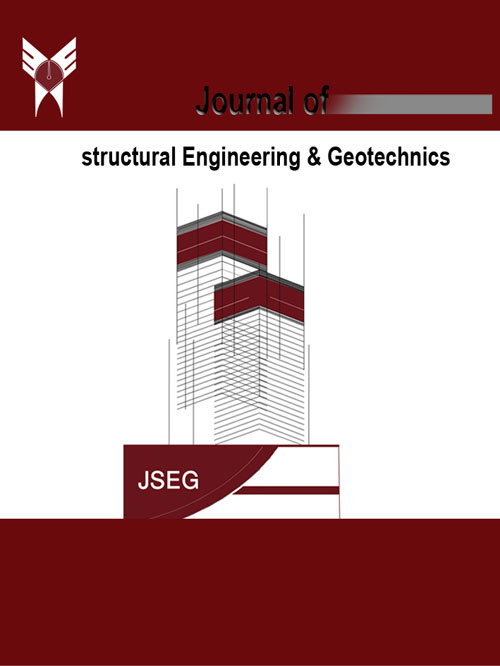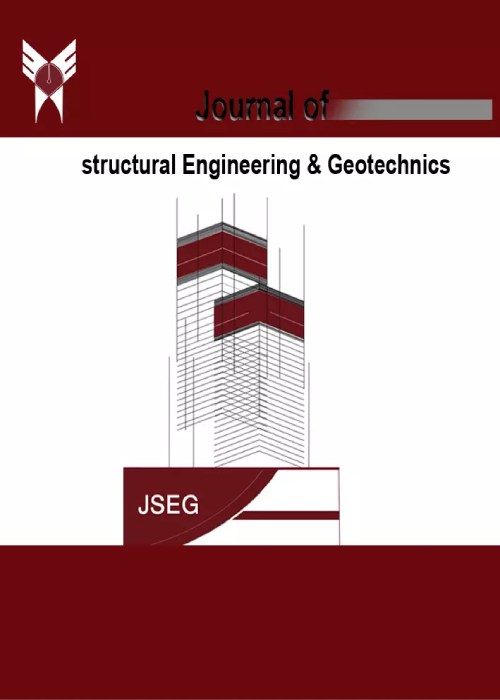فهرست مطالب

Journal of the Structural Engineering and Geotechnics
Volume:8 Issue: 2, Summer and Autumn 2018
- تاریخ انتشار: 1397/06/18
- تعداد عناوین: 6
-
Pages 1-12In recent decades, the use of self-consolidating concrete has become widespread. Hence, recognizing the various properties of self-consolidating concrete are essential. In this study, several mixture designs have been tested and final mixture design of crushed tile aggregates which were replaced by 0%, 25 %, 50%, and 100% volume percentage of natural aggregates were conducted. To evaluate fresh properties of SCC, slump flow and rheometer tests were carried out. Results show that the percentage of fine aggregates has a significant impact on the properties of self-consolidating concrete. In addition, the results of rheometer test show by increasing the percentage of recycled aggregates increases yield stress and plastic viscosity, significantly.Keywords: self-consolidating concrete, SCC, recycled aggregates, rheometer test, natural aggregates, fresh properties
-
Pages 13-22Estimation of sediment transport load due to erosion in river basins is one of the issues which is indispensable for many projects related to water resources, soil and damps construction. With regards to the phenomenon of erosion and transmission Sedimentation in rivers has always led to deformation in the seaboard and sedimentation, so the management and planning in bank of rivers is important in water and soil resources and damp construction. Therefor checking the flow capacity of the sediment transportation and the sediment transportation mechanism in the river hydraulics and their sedimentation in dams are always one of the most fundamental problems in dams construction, and consumable life of dams are also directly related to this phenomenon. To deals with this issue, in this research, after predicting the 57-year-old sediment, the effects of sediment on Polrood earth-filled dam has been investigated by using FLAC3D software, which results show that the effective stress and displacement in the upstream shell is approximately equal to the state without applying sediment pressure.Keywords: Sediment load, earth-filled Polrood dam, Sediment forecasting, FLAC3D software
-
Pages 23-30Self-compacting concrete is a new high performance concrete with high ductility and segregation resistance. In recent years, construction material manufacturers have focused their attention on lightweight concrete and have strived to use lightweight concrete, if possible, in load-bearing parts of buildings. Concrete with both self-compacting and lightweight properties is favourable in this context which is the so-called lightweight self-consolidating concrete. Given the novelty of self-compacting concrete industry and increased amount of construction materials resulting from earthquake (due to seismic hazards of Iran) and destruction of different buildings, in particular urban decay, on the other hand, feasibility study on production of self-compacting concrete with these materials is justifiable in terms of costs, environment protection and energy conservation. Accordingly, coordination between self-compacting factor and utilising these materials is important. So, in this research, the effect of recycled aggregates on mechanical properties of lightweight self-compacting concrete was investigated. Specimens were analysed using 2 mix designs with different contents (cement) by Slump, J-Ring and compressive strength tests. Results indicated that mix designs containing waste LECA have good consistency and stability. Also, mix designs containing waste scoria have high strength. Hence, in order to achieve self-compacting and lightweight properties, it seems logical to use those two waste materials.Keywords: self-compacting concrete, lightweight concrete, recycled aggregates, Compressive strength
-
Pages 31-44In this paper, the spectral ratio of mmicrotremor, HSVR, is presented for estimating the liquefaction potential of layered soil in the coastal area of the Persian Gulf, which consists of a hard sandstone layer situated between two saturated sandy layers. The surface layer is thin, with a thickness between 2 and 5 meters. The purpose of this paper is to identify the relation between the liquefaction potential, the natural frequency and the amplification factor values using microtremors. Liquefaction assessment was done at 27 stations using the HVSR approach provided by Nakamura [1]. HVSR analysis was carried out using the Geopsy software. According to the results of the analysis, the predominant frequency values range from about 0.8 Hz to 2.4 Hz and the amplification factor values range from 1.1 to 2.8. Based on these parameters, the vulnerability index Kg is determined, which can be used as a parameter in calculating the liquefaction potential of an area. The results show that the vulnerability index is related to the sedimentary depth as well as the frequency and amplification factor. Furthermore, the calculated results confirm that the southern area of Bushehr City, which is larger than other areas, has a high liquefaction potential. Furthermore, it is possible to determine the limit of Kg to estimate the liquefaction hazard. Comparing the results confirms that in Bushehr, a soil layer is liquefiable if its related Kg value is over 1.7. This value may change with the conditions of the layer and the soil specification.Keywords: Soil liquefaction, microtremor HVSR, predominant frequency, amplification factor, vulnerability index
-
Pages 45-56Recorded ground motions in near fault region have completely distinct nature from others that recorded in far field of the fault. Near source outcomes cause much of the seismic energy to appear in a single large and long period pulse at the beginning of the velocity record. Assaluyeh complex is located near the reverse Assaluyeh fault that is a segment of Mountain Front Fault. This complex contains facilities which have a wide range of structural periods. Effects of this vicinity on seismic hazard of this region can be considered by using approaches which incorporate effects of near fault in seismic hazard analysis. It can be achieved by using near source specific ground motion models in probabilistic seismic hazard analysis and using accelerograms which contain the pulse-like effects of forward directivity. The results indicate that the site-specific design spectra of this study fall at an upper level in comparison with the standard design spectra of Iranian 2800 standard and the specific design spectrum of International Institute of Earthquake Engineering and Seismology (IIEES). It is worth noting that near fault effects should be considered in probabilistic seismic hazard analysis and preparation of site specific design spectra if the site is located near source region of a fault.Keywords: Forward directivity, Design Spectrum, Near fault
-
Pages 57-68The purpose of this paper is to review computational methods in structure-soil-structure interaction. As a result of globalization, buildings are located close to each other. This issue happens especially in big cities, making the study of structure-soil-structure interaction as an essential part of structural design process. The effect of soil medium, on which the building structure stands, especially on seismic behavior of building is well known. The effects of structures standing in a close distant to each other is the main issue in structure-soil-structure interactions. In this paper, analytical models of soil are reviewed. After a review on different analytical models of soil, the concepts and the computational efforts in the field of interaction between soil and adjacent buildings are discussed in order to provide the reader with the benefits and weaknesses of each concept. Different computer programs which suit structure-soil-structure interaction analysis and their main abilities are briefly reviewed as well.Keywords: structure-soil-structure interaction, seismic performance, soft soil


